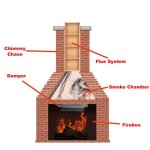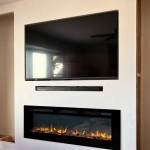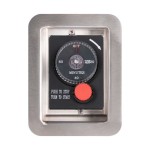Can I Install A Wood Burning Stove In An Existing Fireplace?
The question of whether a wood burning stove can be installed in an existing fireplace is a common one, particularly for homeowners seeking to enhance the efficiency and heating capabilities of their homes. While the answer is generally yes, numerous factors must be considered to ensure a safe and compliant installation. This article will delve into the essential aspects of this process, providing a comprehensive overview for those contemplating this type of home improvement.
Many older fireplaces, particularly masonry fireplaces, are notoriously inefficient, losing a significant amount of heat up the chimney. A wood burning stove, on the other hand, is designed for efficient combustion and heat retention. Installing a stove within an existing fireplace can offer a considerable improvement in heating performance, reducing fuel consumption and providing a more consistent and controlled source of warmth.
However, it's not as simple as just placing a stove inside the firebox. Proper installation requires careful planning and adherence to building codes and safety regulations. Ignoring these considerations can lead to serious risks, including fire hazards and carbon monoxide poisoning.
Key Point 1: Thorough Inspection and Chimney Assessment
Before even considering the purchase of a wood burning stove, a comprehensive inspection of the existing fireplace and chimney is paramount. This inspection should be conducted by a qualified professional, such as a certified chimney sweep or a licensed contractor specializing in fireplace and stove installations. The inspection will assess the structural integrity of the fireplace, including the firebox, hearth, and surrounding masonry. Cracks, crumbling mortar, and other signs of damage must be addressed before proceeding.
The chimney is a critical component and requires particularly close attention. The inspector will evaluate the flue for blockages, such as bird nests or creosote buildup. Creosote, a flammable byproduct of wood combustion, can accumulate over time and pose a significant fire hazard. The flue's size and condition are also crucial. The stove's exhaust outlet needs to be appropriately sized for the chimney flue to ensure proper drafting and prevent backdrafting of smoke and dangerous gases into the home.
In many cases, an existing chimney flue will require relining with a stainless steel liner to ensure a safe and efficient connection to the stove. This liner provides a smooth, airtight pathway for the exhaust gases and protects the masonry from the corrosive effects of flue gases. The diameter of the liner is determined by the stove's specifications and the manufacturer's recommendations. A chimney that is not adequately sized or properly lined can lead to poor stove performance, increased creosote buildup, and an elevated risk of carbon monoxide poisoning.
Key Point 2: Stove Selection and Sizing
Choosing the right wood burning stove is crucial for both safety and efficiency. The stove should be appropriately sized for the space it is intended to heat. An oversized stove can lead to overheating and discomfort, while an undersized stove may not adequately heat the room. Stove sizing is usually expressed in British Thermal Units (BTUs). A qualified professional can help determine the appropriate BTU output based on the room's size, insulation levels, and climate.
Beyond heating capacity, consider the stove's emissions. The Environmental Protection Agency (EPA) regulates wood burning stoves to reduce particulate matter emissions. Look for EPA-certified stoves, which are designed to burn wood more cleanly and efficiently. These stoves typically have advanced combustion systems that reduce smoke and creosote formation.
The stove's design and clearances are also important considerations. The stove must be installed with adequate clearances from combustible materials, such as walls, floors, and furniture. These clearances are specified by the stove manufacturer and are essential for preventing fires. If the existing fireplace does not provide sufficient clearances, additional heat shielding may be required.
Key Point 3: Installation Procedures and Building Codes
The installation of a wood burning stove in an existing fireplace is not a do-it-yourself project for most homeowners. Due to the safety and complexity involved, it is highly recommended to hire a qualified professional installer. A professional installer will be familiar with local building codes and regulations, as well as the proper installation techniques for wood burning stoves.
Building codes typically cover aspects such as flue liner installation, chimney connections, hearth protection, and clearances to combustible materials. Failure to comply with these codes can result in fines, insurance complications, and, most importantly, increased safety risks. A professional installer will obtain the necessary permits and ensure that the installation meets all applicable requirements.
The installation process typically involves connecting the stove to the flue liner using a stovepipe. The stovepipe should be of the correct diameter and material, and it should be properly sealed to prevent leaks. The hearth in front of the fireplace must also be adequately protected with a non-combustible material to prevent sparks or embers from igniting flooring. Carbon monoxide detectors should be installed in the home to provide an early warning in case of a malfunction or incomplete combustion.
Following installation, it is crucial to have the stove inspected by a qualified professional to ensure that it is operating safely and efficiently. Regular maintenance, including chimney cleaning and stove inspections, is essential for maintaining optimal performance and preventing safety hazards over the long term.
In conclusion, installing a wood burning stove in an existing fireplace can be a worthwhile investment, offering improved heating efficiency and a cozy ambiance. However, a thorough inspection, proper stove selection, and professional installation are critical for ensuring a safe and compliant setup. Adhering to building codes and maintaining the stove and chimney regularly will help ensure years of reliable and safe heating.

Converting A Fireplace To Wood Burning Stove Chesneys

Can You Install A Wood Burning Stove In An Existing Fireplace

Can You Install A Wood Burning Stove

Can You Install A Wood Stove In Fireplace Direct Stoves

Converting A Fireplace To Wood Burning Stove Chesneys

Can You Install A Wood Burning Stove In An Existing Fireplace

How To Prepare A Chimney For Wood Burning Stove Houzz Ie

How To Install A Wood Burning Stove In Fireplace

Woodburner Installations In Victorian Fireplaces Cosy Stoves

Victorian Fireplace Hobbit Installation Small Stoves








